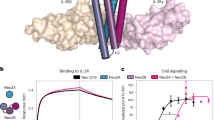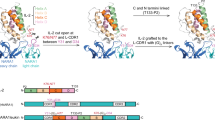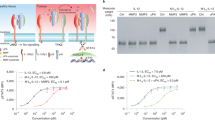Abstract
Interleukin-12 (IL-12) is a heterodimeric cytokine with potent immunostimulatory activity and anti-angiogenic properties. Its clinical applications are limited, however, by severe side-effects. Here we report that an IL-12 fusion protein, consisting of IL-12 fused to a human antibody fragment specific to the oncofetal ED-B domain of fibronectin, markedly enhances the antitumor activity of this cytokine, as demonstrated in a mouse lung-metastasis model and in two models of mice bearing different aggressive murine tumors. The residual small tumor masses seen in the treated mice were infiltrated with lymphocytes, macrophages, and natural killer cells and had elevated interferon γ (IFN-γ). These results are of therapeutic relevance as the ED-B domain of fibronectin, a naturally occurring marker of angiogenesis identical in mouse and man, is expressed in the majority of aggressive solid tumors but is not detectable in normal vessels and tissues.
This is a preview of subscription content, access via your institution
Access options
Subscribe to this journal
Receive 12 print issues and online access
$209.00 per year
only $17.42 per issue
Buy this article
- Purchase on Springer Link
- Instant access to full article PDF
Prices may be subject to local taxes which are calculated during checkout





Similar content being viewed by others
References
Tsung, K., Meko, J.B., Peplinski, G.R., Tsung, Y.L. & Norton, J.A. IL-12 induces T helper 1–directed antitumor response. J. Immunol. 158, 3359–3365 (1997).
Brunda, M.J. et al. Antitumor and antimetastatic activity of interleukin 12 against murine tumors, J. Exp. Med. 178, 1223–1230 (1993).
Rodolfo, M. & Colombo, M.P. Interleukin-12 as an adjuvant for cancer immunotherapy. Methods 19, 114–120 (1999).
Nastala, C.L. et al. Recombinant IL-12 administration induces tumor regression in association with IFN-γ production. J. Immunol. 153, 1697–1706 (1994).
Atkins, M.B. et al. Phase I evaluation of intravenous recombinant human interleukin 12 in patients with advanced malignancies. Clin. Cancer Res. 3, 409–417 (1997).
Car, B.D., Eng, V.M., Lipman, J.M. & Anderson, T.D. The toxicology of interleukin-12: a review. Toxicol. Pathol. 27, 58–63 (1999).
Jain, R.K. & Baxter, L.T. Mechanisms of heterogenous distribution of monoclonal antibodies and other macromolecules in tumors: significance of elevated interstitial pressure. Cancer Res. 48, 7022–7032 (1988).
Folkman, J. Angiogenesis in cancer, vascular, rheumatoid and other disease. Nat. Med. 1, 27–31 (1995).
Voest, E.E. et al. Inhibition of angiogenesis in vivo by interleukin 12. J. Natl. Cancer Inst. 87, 581–586 (1995).
Duda, D.G. et al. Direct in vitro evidence and in vivo analysis of the antiangiogenesis effects of interleukin 12. Cancer Res. 60, 1111–1116 (2000).
Zardi, L. et al. Transformed human cells produce a new fibronectin isoform by preferential alternative splicing of a previously unobserved exon. EMBO J. 6, 2337–2342 (1987).
Carnemolla, B. et al. A tumour-associated fibronectin isoform generated by alternative splicing of messanger RNA precursors. J. Cell. Biol. 108, 1139–1148 (1989).
Castellani, P. et al. The fibronectin isoform containing the ED-B oncofetal domain: a marker of angiogenesis. Int. J. Cancer 59, 612–618 (1994).
Kaczmarek, J. et al. Distribution of oncofetal fibronectin isoforms in normal, hyperplastic and neoplastic human breast tissues. Int. J. Cancer 58, 11–16 (1994).
Viti, F., Tarli, L., Giovannoni, L., Zardi, L. & Neri, D. Increased binding affinity and valence of recombinant antibody fragments lead to improved targeting of tumoral angiogenesis. Cancer Res. 59, 347–352 (1999).
Birchler, M., Viti, F., Zardi, L., Spiess, B. & Neri, D. Selective targeting and photocoagulation of ocular angiogenesis mediated by a phage-derived recombinant antibody. Nat. Biotechnol. 17, 984–988 (1999).
Nilsson, F., Koshmehl, H., Zardi, L. & Neri, D. Targeted delivery of tissue factor to the ED-B domain of fibronectin, a marker of angiogenesis, mediates the infarction of solid tumours in mice. Cancer Res. 61, 711–716 (2001).
Lieschke, G.J., Rao, P.K., Gately, M.K. & Mulligan, R.C. Bioactive murine and human interleukin-12 fusion proteins which retain antitumor activity in vivo. Nat. Biotechnol. 15, 35–40 (1997).
Smith-Gill, S.J., Mainhart, C.R., Lavoie, T.B., Rudikoff, S. & Potter, M. VL–VH expression by monoclonal antibodies recognizing avian lysozyme. J. Immunol. 132, 963–967 (1984).
Hopp, T.P. et al. A short polypeptide marker sequence useful for recombinant protein identification and purification. Bio/Technology 6, 1204–1210 (1988).
Graham, F.L., Smiley, J., Russell, W.C. & Nairn, R. Characteristics of a human cell line transformed by DNA from human adenovirus type 5. J. Gen. Virol. 36, 59–72 (1977).
Tarli, L. et al. A high affinity human antibody that targets tumoural blood vessels. Blood 94,192–198 (1999).
King, D.J. et al. Improved tumor targeting with chemically cross-linked recombinant antibody fragments. Cancer Res. 54, 6176–6185 (1994).
Demartis, S., Tarli, L., Borsi, L., Zardi, L. & Neri, D. In vivo targeting of tumour neo-vasculature by a radiohalogenated human antibody fragment specific for the ED-B domain of fibronectin. Eur. J. Nucl. Med. 28, 534–539 (2001).
Trinchieri, G. Interleukin-12: a cytokine produced by antigen-presenting cells with immunoregulatory functions in the generation of T-helper cells type 1 and cytotoxic lymphocytes. Blood 84, 4008–4027 (1994).
Halin, C. & Neri, D. Antibody-based targeting of angiogenesis. Crit. Rev. Ther. Drug Deliv. Syst. 18, 299–339 (2001).
Boehm, U., Klamp, T., Groot, M. & Howard, J.C. Cellular responses to interferon-γ. Annu. Rev. Immunol. 15, 749–795 (1997).
Tannenbaum, C.S. & Hamilton, T.A. Immune-inflammatory mechanisms in IFN-γ-mediated anti-tumor activity. Semin. Cancer 10, 113–123 (2000).
Bosslet, K. et al. Elucidation of the mechanism enabling tumor selective prodrug monotherapy. Cancer Res. 58, 1195–1201 (1998).
Tarli, L. Tumour targeting and therapy experiments using a chemically-modified human antibody fragment directed against the ED-B domain of fibronectin, a marker of angiogenesis (PhD dissertation). (Swiss Federal Institute of Technology, Zürich, Diss. ETH no. 12680; 2000).
Lode, H.N. et al. Natural killer cell-mediated eradication of neuroblastoma metastases to bone marrow by targeted interleukin-2 therapy. Blood 91, 1706–1715 (1998).
Peng, L.S., Penichet, M.L. & Morrison, S.L. A single-chain IL-12 IgG3 antibody fusion protein retains antibody specificity and IL-12 bioactivity and demonstrates antitumor activity. J. Immunol. 163, 250–258 (1994).
Oppmann, B. et al. Novel p19 protein engages IL-12p40 to form a cytokine, IL-23, with biological activities similar as well as distinct from IL-12. Immunity 13, 715–725 (2000).
Bernstine, E.G., Hooper, M.L., Grandchamp, S. & Ephrussi, B. Alkaline phosphatase activity in mouse teratoma. Proc. Nat. Acad. USA 70, 3899–3903 (1973).
Corbett, T.H., Griswold, D.P., Roberts, B.J., Peckham, J.C. & Schabel, F.M. Tumor induction relationships in development of transplantable cancers of the colon in mice for chemotherapy assays, with a note in carcinogen structure. Cancer Res. 35, 2434–2439 (1975).
Neri, D. et al. Radioactive labeling of recombinant antibody fragments by phosphorylation using human casein kinase II and [γ-32P]ATP. Nat. Biotechnol. 14, 485–490 (1996).
Gately, M.K., Chizzonite, R. & Presky, D.H. Measurement of human and mouse interleukin-12. in Current protocols in immunology (eds. Coligan, J.E., Kruisbeek, A.M., Margulies, D.H., Shevach, E.M. & Strober, W.) 6.16.1–6.16.15 (John Wiley & Sons, New York; 1995).
Acknowledgements
This work was supported by grants from the Krebsforschung Schweiz, the Bundesamt für Bildung und Wissenschaft (EC Project) and ETH Zürich (D.N.), the Thüringer Ministerium für Wissenschaft, Forschung und Kultur (IZKF and HSPIII projects) (H.K.), and the Associazione Italiana Ricerca sul Cancro (A.I.R.C.) (L.Z.).
Author information
Authors and Affiliations
Corresponding author
Ethics declarations
Competing interests
D.N. and L.Z. are consultants and shareholders of Philogen, a biotechnology company that has acquired the rights to the L19 antibody from their academic institutions (the Swiss Federal Institute of Technology Zürich and the National Cancer Research Institute, Genoa, respectively).
Rights and permissions
About this article
Cite this article
Halin, C., Rondini, S., Nilsson, F. et al. Enhancement of the antitumor activity of interleukin-12 by targeted delivery to neovasculature. Nat Biotechnol 20, 264–269 (2002). https://doi.org/10.1038/nbt0302-264
Received:
Accepted:
Issue Date:
DOI: https://doi.org/10.1038/nbt0302-264
This article is cited by
-
A novel strategy to generate immunocytokines with activity-on-demand using small molecule inhibitors
EMBO Molecular Medicine (2024)
-
The present and future of immunocytokines for cancer treatment
Cellular and Molecular Life Sciences (2022)
-
Interleukin-12 as an in situ cancer vaccine component: a review
Cancer Immunology, Immunotherapy (2022)
-
Fibronectin as a multiregulatory molecule crucial in tumor matrisome: from structural and functional features to clinical practice in oncology
Journal of Experimental & Clinical Cancer Research (2021)
-
Collagen-binding IL-12 enhances tumour inflammation and drives the complete remission of established immunologically cold mouse tumours
Nature Biomedical Engineering (2020)



